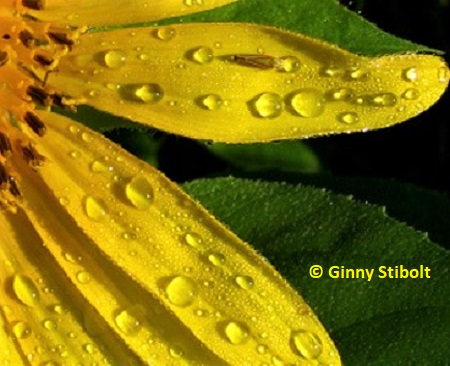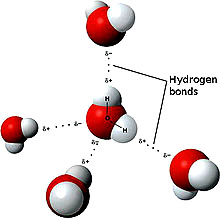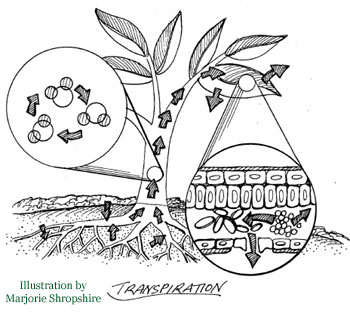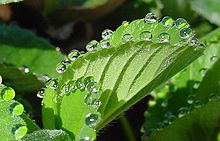|

Water science and gardening
by Ginny Stibolt
Without water life, as we know it, would not exist. Plants and animals
contain high percentages of water and depend upon its unique properties
to survive. Humans are attracted to bodies of water for both their
beauty and their usefulness for many aspects of our lives.
What makes water special and why do we gardeners
care?
Water is made up of two hydrogen atoms and one oxygen atom giving
it the familiar chemical formula of H20. The hydrogen atoms
attach themselves to one side of the oxygen, covering about 1/3 of a
circle, and so that the molecules look very much like Mickey Mouse ears.
The side of the molecule with the hydrogen atoms has a slight positive
charge and the oxygen side is slightly negative. Water molecules act
like little magnets and are attracted to each other and form weak bonds,
called hydrogen bonds. You notice this self-attraction, called cohesion,
when water beads up into droplets as seen on my sunflower petals in
the morning light in the photo above.
 Water's polarity makes it a good solvent
that can break apart, absorb, and carry organic materials such as sugars,
other carbohydrates, and nutrients. Water's polarity makes it a good solvent
that can break apart, absorb, and carry organic materials such as sugars,
other carbohydrates, and nutrients.
Water is highly unusual as well, because it can exist simultaneously
as a gas (water vapor), liquid. and a solid (ice). The solid form is
unique because it is less dense than the liquid due to its crystalline
structure and floats on the liquid. Water readily evaporates into the
atmosphere and gathers as mist or clouds.
Knowing how plants deal with and take advantage of water's unique chemistry
makes us better gardeners.
Osmosis and root hairs
Starting at the bottom, near the tip of the roots, there are thousands
of single-cell extensions on the root's surface called root hairs that
absorb water from the soil. Root-hair cells have a semi-permeable cell
membrane that allows water and some materials that are dissolved
in water, such as nutrients, to flow into the cell. Everything else
is blocked from entry into the plant. Water will equalize over an area
and when there is less water within the root-hair cells than in the
surrounding soil, then the water flows across the cell membrane to equalize
that pressure. Once water fills the root hair cells, it flows into neighboring
cells and builds up pressure that pushes water up into the plant; this
is called root pressure. Then the process of transpiration, as discussed
below, carries the water farther up the plant.
Root hairs usually last just a few weeks before they are reabsorbed
into the root tissue--a root must be growing in order to develop new
root hairs. As gardeners we need to keep in mind when irrigating
plants, we need to supply water to the region where new roots are growing.
Roots of established trees and shrubs might be growing yards away from
the trunks or stems.
When a plant is transplanted, most of its delicate root hairs are rubbed
off as soil falls away from roots, so these plants need a lot of water
in the planting hole and frequent irrigation until new root growth begins
and the plant regains its network of root hairs. The larger the plant,
the longer the time period when additional irrigation is necessary for
the establishment of that plant. For irrigation details and other
transplanting information see Trees and Shrubs:
the "Bones" of Your Landscape. Good gardeners want their plants
to survive, so we need to pay close attention during their establishment
period. This is true for drought-tolerant plants as well--you can't
plant it and forget it. A drought-tolerant plant needs the same
TLC after transplanting as other plants. It only becomes truly drought
tolerant after it's fully established in its new location.
Before we leave water's interaction with roots and soil, let's kill
an old gardeners' tale. For years we've been advised to lay a
thick layer of gravel or potshards in the bottom of our pots and containers
to aid drainage. It was shown 100 years ago that this is false, but
even today, so-called gardening experts and master gardeners continue
to pass this myth on as if it were fact. Because of water's tendency
to hang together, it will be reluctant to jump the gaps created a coarse
medium such as gravel. It won't move away from the fine medium of soil
until it's completely saturated. In order to create the best drainage
in your container gardens, use taller pots and use all soil with just
a screen or leaves covering the drainage holes. You can test for the
effectiveness of the taller pots with a simple cellulose kitchen sponge:
Completely saturate the sponge and hold it in the horizontal position
over the sink until it stops dripping. Then turn it so that it is vertical
and after a short delay the sponge will give up more of its water. Isn't
science fun when you can apply it in your gardening? For further reference,
here is a link to Dr Linda Chalker-Scott's peer-reviewed paper: The
Myth of Drainage Material in Containers.
 Transpiration Transpiration
After water enters the root tissues, there is pressure that begins
to push the water higher in the plant. But it would not go very far
up the water-carrying cells in plants, called xylem, without the suction
effect of evaporation through the pores in the leaves and stems called
stomata. For many years it was thought that capillary action (movement
of a liquid up a narrow tube) accounted for much of this movement, but
more advanced measuring techniques show that capillary action is not
a major factor in water movement through the xylem.
More than 90% of the water that enters a plant runs straight through
it and evaporates into the air. A full-grown oak tree could transpire
more than 400 gallons of water on a summer day. The larger the plant,
the higher the volume of transpiration. The area near large plants
is cooled by the transpiration process and on a hot day; the temperatures
may be up to 20 degrees cooler than nearby spaces without large plants.
As gardeners, we use this information in designing our outdoor spaces
and placing plants near buildings to reduce the need for air conditioning.
The transpiration rate is also important in planting our
rain gardens. Rain gardens are designed to collect rainwater in
swales. The water will be both absorbed by the plants and also
percolate into the soil to refresh our aquifers. A rain garden should
not have standing water for more than 3 days--the more biomass in the
rain garden plants, the higher the transpiration rate and the faster
water is sucked from the soil.
The remaining 10% of the water that is absorbed into the plant's cells
serves several purposes: it carries nutrients, it keeps the cells turgid
and it will also be used by the plant for photosynthesis during the
daylight. When the soil is dry, this whole process slows down. The guard
cells around each stomate are highly sensitive to water supply and when
they become flaccid, the stomata close up, and the evaporation of water
is slowed to protect against severe wilting. Gardeners need to
pay attention to the wilting of plants--especially seedlings--and irrigate
before permanent damage is done to the plant's tissue.
 Guttation Guttation
When the temperature lowers at night, less water evaporates into the
air. Nighttime temperatures put the brakes on the transpiration
rate, but in many types of plants, the root pressure is not immediately
reduced, so there is a flow of water from the leaves at night to relieve
the pressure. This is called guttation.
The water is excreted as liquid through specialized pores called hydathodes
at the ends of veins. (The strawberry leaf in this photo illustrates
this process.) If the plant is a salt tolerant plant, you can often
see a build up of salt crystals near these pores.
This excreted water is often confused with dew, but the source of the
water is not the same. The water from guttation comes through the plant,
while dew is formed when water vapor in the air condenses on plant surfaces
in the cool night air. Dewdrops form randomly on plants and will not
form neat droplets at the ends of veins or at the tips of narrow blade-like
leaves. Some of the water--both from dew and guttation--on plant surfaces
may be absorbed through stomata on plant surfaces the next morning when
the temperature rises again, but most of it will either drop to the
ground or evaporate into the air.
As gardeners, it's good to be aware of this cycle of water as we keep
a close watch on our plants. Most people recommend that we irrigate,
if needed, in the morning so the plants have all day to cycle the water,
dry plant surfaces at night are less vulnerable to fungus attacks, and
so that less water is lost to evaporation during irrigation. Also, if
you water at night much of the water may be out of reach of the roots
by the time the plant is ready to restart the transpiration cycle.
Water drops act like little magnifying lenses or prisms and if you
look closely you can often see rainbows in the drops. They are beautiful,
and contrary to the old gardeners' tale, the water drops on leaves in
the full sun will not burn the leaf tissue. So you may irrigate without
fear in the middle of the day if your plants--again particularly seedlings--are
wilting in the Florida heat.
Photosynthesis
This magical process wherein green plants combine carbon dioxide (CO2)
and water (H2O) with energy from sunlight to form sugar (C6H12O6)
and oxygen gas (O2). For
most vascular plants, the water is supplied by transpiration flow and the
carbon dioxide is available from the air through the open stomata. (Respiration is
the equal and opposite chemical reaction, and all organisms respire as
they gain energy for living.)
When it gets too hot and plants close up their stomata to preserve
water, most plants cannot continue photosynthesizing because they don't
have ready access to water and carbon dioxide. Some heat-loving plants
have adapted to make better use of the sunlight in the heat. Read The
Science Behind Southern Grasses, Including Turf to learn how they
do it.
Water: it's a limited resource
Before we knew better, we wasted much of our water and used up or spoiled
many of our water resources. Water, especially usable fresh water, is
a limited resource and as gardeners we can do our part and create water-wise
landscapes.
For a good review of Florida's water resources, see the Florida Native
Plant Society's post We
All Live in A Watershed.
| 


 Water's polarity makes it a good solvent
that can break apart, absorb, and carry organic materials such as sugars,
other carbohydrates, and nutrients.
Water's polarity makes it a good solvent
that can break apart, absorb, and carry organic materials such as sugars,
other carbohydrates, and nutrients. Transpiration
Transpiration Guttation
Guttation